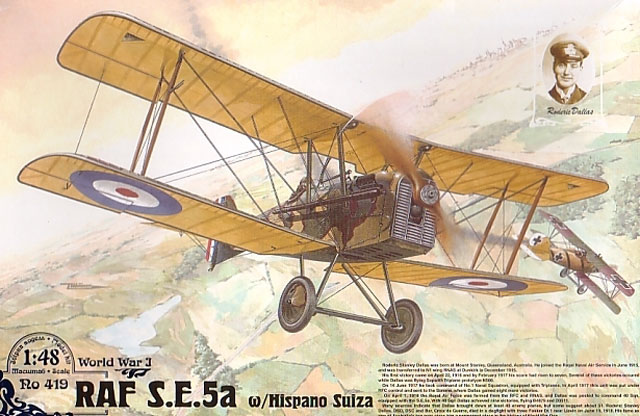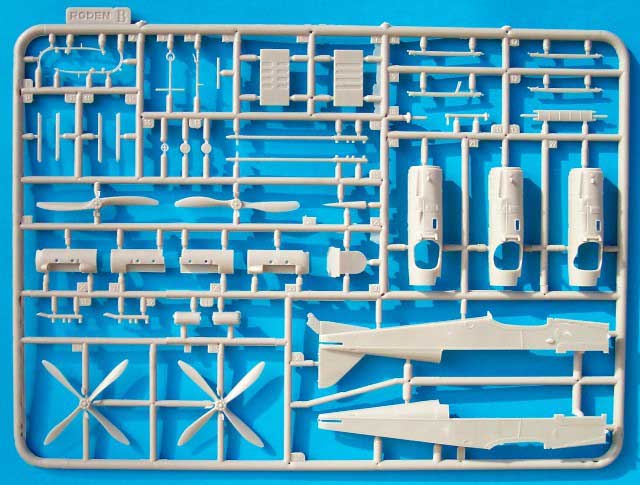|
RAF SE5a
w/Hispano Suiza

Roden 1/48
S
u m m a r y
|
| Catalogue Number: |
Roden SE5a w/Hispano Suiza kit #419 |
| Scale: |
1/48 |
| Contents and Media: |
87 parts in injection moulded
plastic; acetate sheet for windscreens; markings for three aircraft |
| Price: |
USD$17.96 from Squadron.com |
| Review Type: |
FirstLook |
| Advantages: |
Well researched, excellent detail,
new rigging diagram, six decal options. |
| Disadvantages: |
Roundels still out of register |
| Recommendation: |
Recommended |
Reviewed by Robert Baumgartner

Roden's 1/48
scale RAF SE5a (Hispano Suiza version)
is available online from Squadron.com
Roden has followed on from their “Viper” kit with the much
anticipated release of the Hispano Suiza powered SE5a. There are no new
sprues to be found when one counts the 87 items. Instead the previous
closed gates have all been opened to allow the full gamut of parts to be
produced. Thus there are welcome spares everywhere!
New items include the radiator, a couple of types of four bladed
propeller, engine cowls, short exhausts, small and long cord elevators,
two more cockpit/deck arrangements, and off course McCudden’s LVG C.V
spinner.

Click the thumbnails below
to view larger images:
The rest of the sprue contains the familiar items seen in the earlier
kit. Included are the row of 4 x 25lb Cooper bombs, headrest, separate
wheel covers and both the steel and later wooden undercarriage legs.
Roden’s usual delicate machine guns can be found and the superbly done
Foster mounting is as crisp as ever. This latter item comes with and
without spacers.
An acetate sheet is supplied and this contains the windscreen as well as
the “window” that allowed light into the cockpit area.
When properly scaled general arrangement drawings are used for
comparison, it is clear that Roden have done their homework. The
outlines of the major components match up very well. Due to the large
number of manufacturers involved there can be slight differences between
aircraft. For this reason it is imperative that the builder checks their
subject carefully. One case in point being the access plates to the rear
of the engine.
It is also commendable to see that Roden have continued to supply their
corrected wing in this version. The flying surfaces of these components
are very subtle with exquisite trailing edges. Both wings are moulded as
one piece so there will be no alignment or dihedral problems. Although
the ailerons are not separate, the elevators are.
Looking to the inside of the fuselage halves, one will find some useful
structural detail. Thankfully this does not equate to sink marks on the
outer surface. Instead we are treated to a subtle indication that this
was a fabric covered airframe.
The usual office equipment is provided and these consist of the seat,
rudder bar, control column, instrument panel and shelf.
To get the maximum use out of the moulds, the fuselage is broken down
into sub assemblies. Although this may look daunting at first, a little
patience is all that is needed to see things right.
One item missing from its predecessor was the rigging diagram. This time
it is included and kudos to Roden for making the effort to include a
comprehensive set of sketches.
To help keep the instruction sheet uncluttered, the painting guide lists
a breakdown of which exhaust, prop, undercarriage, windscreen etc is
applicable to each version.
The quality of the mouldings was excellent with the only blemish being a
sink mark or two on the engine pieces.
Six aircraft make an appearance on the very large decal sheet.
The red centres to the roundels are printed separately and this
nearly solved the registration problems. Sadly the blue was still
slightly misprinted over the white portion of the roundels.
The carrier film is nice and thin and testing a sample item showed no
potential trouble areas.
RAF SE5a D3511, (Vickers built)
40 Sqn RFC, Major R S Dallas, France, May 1918
On 8 May 1918, D3511 was used to shoot down an Albatros D.V.,
which became the first of five enemy aircraft in this machine. After
his death on another aircraft, D3511 was used to good effect by
Gwilym Lewis who managed to down a Fokker D.VII and LVG within a
week of each other.
RAF SE5a B4891/”6”, (RAF built)
56 Sqn RFC, Capt. J B T McCudden, France, February 1918
McCudden scored his first victory piloting a SE5a with this
aircraft. He flew it from December 1917 until March 1918, before he
left 56 Sqn. The white patches under the lower wing “6” are leftover
markings of the letter ‘G’. This letter was used as a Flight marking
early in McCudden's use of B’4891. When the “G” was changed to a
six, the spinner of an LVG was added, this being from an aircraft he
had shot down the previous November. He shot down more aircraft (32)
in B’ 4891 than in any other machine he flew. After McCudden left,
this aircraft had 2 more successes, this time in the hands of Major
C M Crowe.
RAF SE5a D5995/”1”, (Vickers built)
143(HD) Sqn RFC, Lt L Lucas, London Air Defence, April/May 1918.
Note that this aircraft was fitted with flame dampers.
RAF SE5a B507/”A”, (Vickers built)
60 Sqn RFC, 2/Lt. J J Fitzgerald, France, October 1917
Fitzgerald had engine failure in this machine on 5 October 197
which forced him to land in enemy territory where the machine was
captured intact by the Germans.
RAF SE5a B139, (Martinsyde built)
111 Sqn RFC, Palestine, January 1918
Photographs of this aircraft do in fact show that Roden are
correct in depicting it with rack full of 25-lb Cooper bombs. At one
stage of its life, B139 had what is believed to be an extra
oil-cooling device mounted below the engine. This would have to be
scratch built.
RAF SE5a B4863/”G”, (RAF built)
56 Sqn RFC, Capt. J B T McCudden, France, September 1917
Nine victories were scored in B4863 between the 19th September and
the 21st of October. The aircraft was eventually wrecked when it ran
into a house while landing at night at 53 Sqn.
This is another fine effort from Roden and one that will be much sort
after by modellers in this scale.
The finesse of the kit is first class and the subject matter is sorely
needed.
The new wing and now the inclusion of a rigging diagram show that
Roden are listening to those they are targeting.
Highly Recommended
Thanks to
Squadron.com for the review
sample.
Review and Images Copyright © 2004 by
Robert Baumgartner
Page Created 10 August, 2005
Last updated 10 August, 2005
Back to HyperScale Main Page
Back to Reviews Page
|
Home | What's
New | Features
| Gallery |
Reviews | Reference
| Forum
| Search